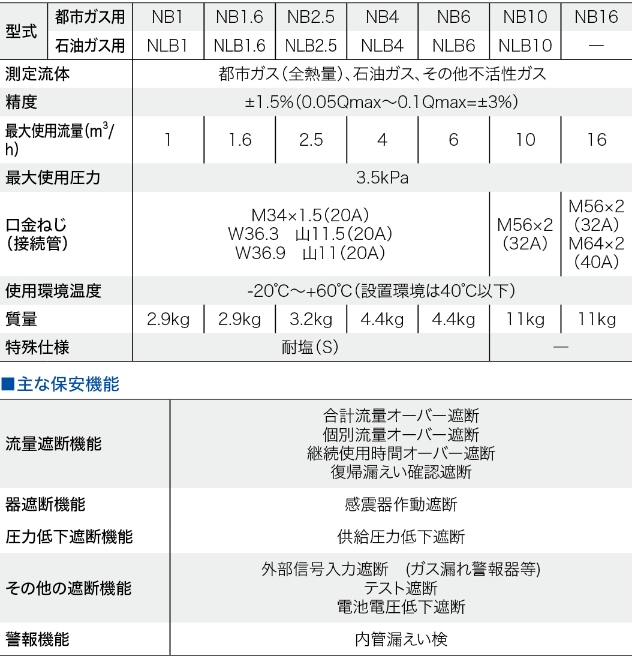- TOP
- About Azbil Kimmon
- History of Azbil Kimmon
- History as a Pioneer in Measuring Instruments
History of Azbil Kimmon
History as a Pioneer in Measuring Instruments
Following in the footsteps of founder Daigen Jumonji, who developed Japan's first gas meter, Azbil Kimmon, as a pioneer of measuring instruments, has produced various products that meet the needs of the times and society over its more than 100-year history.
- 1930: Started full-scale production of die-cast products
- 1939: Started production of large capacity meters for city gas and rotary gas meters
1953: Completed Japan's first dry-type P1 propane gas meter.

Propane gas, which had been used for industrial and household purposes in Europe and the United States from early on, was first introduced in Japan in 1929, when the German airship "Count Zeppelin" flew into Ibaraki Prefecture. The airship used propane gas diluted with hydrogen, and after seeing this, people in Japan renewed their awareness of propane gas and gradually began to use it in their homes.
At that time, propane gas was sold by the cylinder, which caused inconvenience because it was difficult to know how much gas remained.
To solve this problem, we improved the conventional city gas meter and created the first propane gas meter in Japan, "P1 Light.
- ・1959: Started manufacturing mercury lamps made of quartz glass.
1960: Developed the industry's first plastic water meter (PW type), which used plastic material for the meter's inner mechanism.

When the Tokyo Metropolitan Bureau of Waterworks asked us to develop a highly sensitive meter that could catch even the slightest drop of water, we quickly responded to their request, as we had been working on a plastic meter for several years.
By changing the internal mechanism of the meter from metal to plastic, the sensitivity became remarkably sharper than that of the metal meter, which was easily dulled by water stains and free carbonic acid. We have also developed a highly sensitive and durable water meter that can accurately measure a wide range of water volume, from small to large, by making the impeller lighter.
- ・1960: Began production of SW-type meters for agricultural water use.
- ・1964: Developed and started manufacturing T-type gas meter jointly with Tokyo Gas Co.
- ・1968: Completed the GR-EX type (electromagnetic counter type) power-generating separate measurement water meter.
1968: Developed Kimmon advanced payment type gas meter

In 1961, with the remarkable change in lifestyle in Japan, there was a demand for more compact gas meters. With our original design, we developed the H-type gas meter, which is compact, can be installed in any location, and has a sharp sensitivity.
The H-type gas meter's indicator mechanism uses a direct-reading counter that shows the amount of gas used in numerical form, which was highly effective in preventing misinterpretation of gas meter readings by meter readers and consumers.
The Kimmon-type front-end gas meter was developed by attaching a front-end device to the H meter, and when a coin is inserted, the meter discharges the corresponding amount of gas. The convenience of this meter was well received, and it was installed in hospitals and apartments one after another.
- ・1969: Completed drip meter (flowmeter for ultra-low flow rates).
Developed liquid-filled direct-reading water meter.
Began sales of air conditioning equipment (absorption chiller/heaters)
1970: Patented high-performance KB-type water meter developed
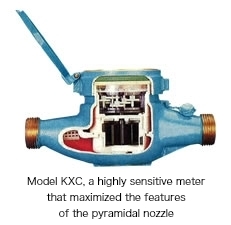
Plastic water meters continued to evolve toward higher performance.
We have developed the KB-type meter, which is considered the ultimate in water meters, by switching the nozzle of the metering chamber from a conventional "round" to a "pyramid" shape to facilitate smooth rotation of the impeller.
The "pyramid-shaped" nozzle was brought to Japan in 1969 through a technical tie-up with Pop und Reuter GmbH of West Germany (now Germany), and we began manufacturing it according to actual conditions.
We were able to adopt this nozzle because the weighing chamber was made of plastic. It would have been impossible to adopt the nozzle if it had been made of metal. We started from making the molds, so it was very difficult to commercialize the product, but we succeeded in commercializing it by utilizing the die casting process technology that Tadashi Onoda, the second president, brought with him from Germany.
The development of the plastic meter contributed greatly to increasing the yield rate of municipal water supply.
- ・1971: Developed the GA type bi-metric water meter.
Began production of OEX-type flowmeter. - ・1972: Developed hot water meters (HWM, HTM).
Started sales of air-conditioning equipment (absorption chiller/heaters) - ・1973: Developed the GI type reverse-proof water meter for separate measurement.
1974: Development of N-type No. 2 with "fan-shaped valve
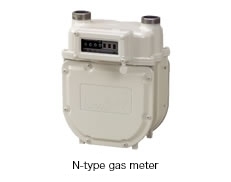
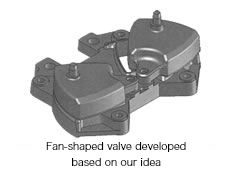
When the Japan Gas Association asked us to research a multifunctional compact gas meter that could be used by any gas company anywhere in Japan, we were quick to develop one.
At the same time, the use of natural gas, which has a higher calorific value than conventional manufactured gas, was becoming increasingly popular in Japan around 1972. In order to measure natural gas, which requires less usage, a meter capable of accurately measuring small flow rates became necessary.
Many of our ideas were adopted in the development of the N-type No. 2 meter, which is a standardized product nationwide. Among them, the "fan-shaped valve" was able to measure a wider range of gases than conventional valves, and this idea was fully recognized and officially adopted for the N-type meter.
1975: Developed and began marketing "Canary," a hot-wire gas alarm.

The Company also actively engaged in the development of gas safety equipment, and completed the first gas leak alarm using a platinum hot wire.
The product name "Canary" was chosen as a nickname after soliciting ideas from employees at the time.
The "Canary" was later combined with the newly developed "Gas Alarm Shutoff Device" and became very effective in terms of safety.
The gas alarm shutoff system is a revolutionary system in which the controller shuts off the gas when the canary detects a concentration that could lead to a gas explosion and sends out a signal.
This will enable Canary to make a significant contribution to gas safety functional aspects and accident prevention.
- ・1978: Development of TB-type meters to measure groundwater in response to regulations on groundwater pumping.
- ・1980: Developed a gas engine heat pump.
- ・1982: Started production and sales of gas engine cogeneration systems
1983: Full-scale production and sales of "My Safe," a city gas meter with a safety function
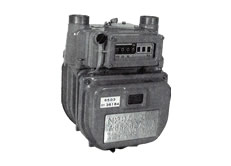
At a time when high-rise buildings and condominiums were being constructed at a rapid pace, gas safety became even more strongly desired by the public. The microcomputer meter combined the metering function of the N-type meter with a safety function, so that in the event of an earthquake of intensity 5 or higher, the microcomputer would automatically shut off the gas supply on command, which greatly increased domestic security related to gas usage.
The microcomputer meter evolved further, and in 1986, the "Microcomputer Meter Type II" was developed with a pressure-sensitive seismic sensor and self-check accident prevention function, as well as a simplified restart method.
From the era of metering-only meters to the era of combined safety, the development of the microcomputer meter marked a major milestone in the history of gas meters.
- ・1986: Development of "LP gas total management system" using telephone lines.
1987: Launched the Shut-off Ace microcomputer meter for LP gas
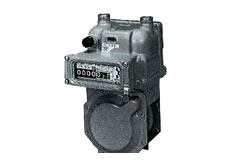
At the time, propane gas was the cause of many accident. The Ministry of International Trade and Industry (MITI) decided that the most effective safety measure was to install safety devices, and microcomputer meters were installed in propane gas as in city gas. This microcomputer meter was given the nickname "Shut-off Ace," and our technical capabilities were put to great use in its development.
Shut-off Ace consultants were appointed to publicize the need for installation to propane gas companies and households throughout Japan, and as a result, the number of accidents involving propane gas in Japan has greatly decreased.
- ・1991: Development of "Underground Buried Type Regulator" in cooperation with Tokyo Gas Co.
Obtained the industry's first approval as a designated manufacturer's business office for hot water meters and total calorimeters.
1999 (Heisei 11): Began sales of "Eco Meter," a water meter using a lead-free copper alloy that complies with the new water quality standards that came into effect in April 2003
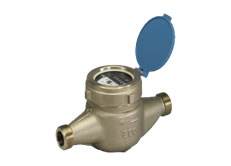
Traditionally, most water fixtures had been made of common bronze castings containing zinc or lead.
In April 2003, in consideration of the effects on the human body, the Ministerial Ordinance on Water Quality Standards tightened the limit of lead leaching into tap water to 0.01 mg/L or less.
We had been working on the development of lead-free copper alloy meters since early on, and by using lead-free copper alloy meter cases, we succeeded in reducing the amount of lead in tap water to less than 0.01 mg/L. We developed a water meter that is friendly to people and the environment.
We established the "environmental protection cycle" from materials to manufacturing and recycling in the water meter field.

